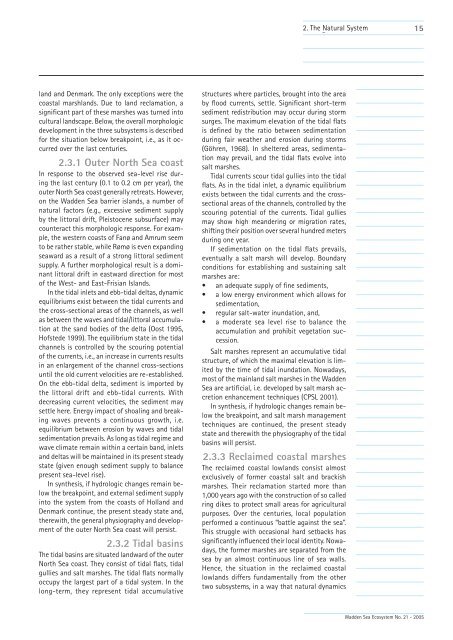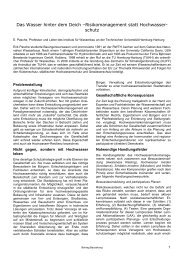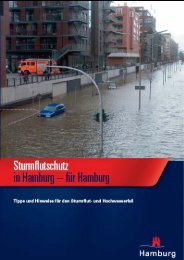Coastal Protection and Sea Level Rise - Hochwasser
Coastal Protection and Sea Level Rise - Hochwasser
Coastal Protection and Sea Level Rise - Hochwasser
You also want an ePaper? Increase the reach of your titles
YUMPU automatically turns print PDFs into web optimized ePapers that Google loves.
2. 3. The Integrated Natural BEP System Solutions<br />
15<br />
l<strong>and</strong> <strong>and</strong> Denmark. The only exceptions were the<br />
coastal marshl<strong>and</strong>s. Due to l<strong>and</strong> reclamation, a<br />
significant part of these marshes was turned into<br />
cultural l<strong>and</strong>scape. Below, the overall morphologic<br />
development in the three subsystems is described<br />
for the situation below breakpoint, i.e., as it occurred<br />
over the last centuries.<br />
2.3.1 Outer North <strong>Sea</strong> coast<br />
In response to the observed sea-level rise during<br />
the last century (0.1 to 0.2 cm per year), the<br />
outer North <strong>Sea</strong> coast generally retreats. However,<br />
on the Wadden <strong>Sea</strong> barrier isl<strong>and</strong>s, a number of<br />
natural factors (e.g., excessive sediment supply<br />
by the littoral drift, Pleistocene subsurface) may<br />
counteract this morphologic response. For example,<br />
the western coasts of Fanø <strong>and</strong> Amrum seem<br />
to be rather stable, while Rømø is even exp<strong>and</strong>ing<br />
seaward as a result of a strong littoral sediment<br />
supply. A further morphological result is a dominant<br />
littoral drift in eastward direction for most<br />
of the West- <strong>and</strong> East-Frisian Isl<strong>and</strong>s.<br />
In the tidal inlets <strong>and</strong> ebb-tidal deltas, dynamic<br />
equilibriums exist between the tidal currents <strong>and</strong><br />
the cross-sectional areas of the channels, as well<br />
as between the waves <strong>and</strong> tidal/littoral accumulation<br />
at the s<strong>and</strong> bodies of the delta (Oost 1995,<br />
Hofstede 1999). The equilibrium state in the tidal<br />
channels is controlled by the scouring potential<br />
of the currents, i.e., an increase in currents results<br />
in an enlargement of the channel cross-sections<br />
until the old current velocities are re-established.<br />
On the ebb-tidal delta, sediment is imported by<br />
the littoral drift <strong>and</strong> ebb-tidal currents. With<br />
decreasing current velocities, the sediment may<br />
settle here. Energy impact of shoaling <strong>and</strong> breaking<br />
waves prevents a continuous growth, i.e.<br />
equilibrium between erosion by waves <strong>and</strong> tidal<br />
sedimentation prevails. As long as tidal regime <strong>and</strong><br />
wave climate remain within a certain b<strong>and</strong>, inlets<br />
<strong>and</strong> deltas will be maintained in its present steady<br />
state (given enough sediment supply to balance<br />
present sea-level rise).<br />
In synthesis, if hydrologic changes remain below<br />
the breakpoint, <strong>and</strong> external sediment supply<br />
into the system from the coasts of Holl<strong>and</strong> <strong>and</strong><br />
Denmark continue, the present steady state <strong>and</strong>,<br />
therewith, the general physiography <strong>and</strong> development<br />
of the outer North <strong>Sea</strong> coast will persist.<br />
2.3.2 Tidal basins<br />
The tidal basins are situated l<strong>and</strong>ward of the outer<br />
North <strong>Sea</strong> coast. They consist of tidal flats, tidal<br />
gullies <strong>and</strong> salt marshes. The tidal flats normally<br />
occupy the largest part of a tidal system. In the<br />
long-term, they represent tidal accumulative<br />
structures where particles, brought into the area<br />
by flood currents, settle. Significant short-term<br />
sediment redistribution may occur during storm<br />
surges. The maximum elevation of the tidal flats<br />
is defined by the ratio between sedimentation<br />
during fair weather <strong>and</strong> erosion during storms<br />
(Göhren, 1968). In sheltered areas, sedimentation<br />
may prevail, <strong>and</strong> the tidal flats evolve into<br />
salt marshes.<br />
Tidal currents scour tidal gullies into the tidal<br />
flats. As in the tidal inlet, a dynamic equilibrium<br />
exists between the tidal currents <strong>and</strong> the crosssectional<br />
areas of the channels, controlled by the<br />
scouring potential of the currents. Tidal gullies<br />
may show high me<strong>and</strong>ering or migration rates,<br />
shifting their position over several hundred meters<br />
during one year.<br />
If sedimentation on the tidal flats prevails,<br />
eventually a salt marsh will develop. Boundary<br />
conditions for establishing <strong>and</strong> sustaining salt<br />
marshes are:<br />
•<br />
•<br />
•<br />
•<br />
an adequate supply of fine sediments,<br />
a low energy environment which allows for<br />
sedimentation,<br />
regular salt-water inundation, <strong>and</strong>,<br />
a moderate sea level rise to balance the<br />
accumulation <strong>and</strong> prohibit vegetation succession.<br />
Salt marshes represent an accumulative tidal<br />
structure, of which the maximal elevation is limited<br />
by the time of tidal inundation. Nowadays,<br />
most of the mainl<strong>and</strong> salt marshes in the Wadden<br />
<strong>Sea</strong> are artificial, i.e. developed by salt marsh accretion<br />
enhancement techniques (CPSL 2001).<br />
In synthesis, if hydrologic changes remain below<br />
the breakpoint, <strong>and</strong> salt marsh management<br />
techniques are continued, the present steady<br />
state <strong>and</strong> therewith the physiography of the tidal<br />
basins will persist.<br />
2.3.3 Reclaimed coastal marshes<br />
The reclaimed coastal lowl<strong>and</strong>s consist almost<br />
exclusively of former coastal salt <strong>and</strong> brackish<br />
marshes. Their reclamation started more than<br />
1,000 years ago with the construction of so called<br />
ring dikes to protect small areas for agricultural<br />
purposes. Over the centuries, local population<br />
performed a continuous “battle against the sea”.<br />
This struggle with occasional hard setbacks has<br />
significantly influenced their local identity. Nowadays,<br />
the former marshes are separated from the<br />
sea by an almost continuous line of sea walls.<br />
Hence, the situation in the reclaimed coastal<br />
lowl<strong>and</strong>s differs fundamentally from the other<br />
two subsystems, in a way that natural dynamics<br />
Wadden <strong>Sea</strong> Ecosystem No. 21 - 2005




